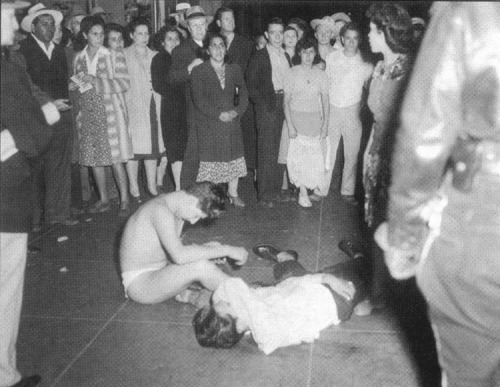The Zoot Suit Riots,In the 1930’s and 40’s the zoot suit became the standard of fashion
The Zoot Suit Riots,In the 1930’s and 40’s the zoot suit became the standard of fashion among American minorities, especially Hispanic, African American, Filipino, and Italian American youth. The zoot suit included included high waisted, wide legged trousers, a long coat with oversized lapels and shoulders (sometimes pinstriped), thick soled shoes, and was often worn with a fedora or “porkpie” hat. The zoot suit was all about flashiness, swagger, and eccentricity, hence why it was the popular dress of many jazz artists of the day, such as the legendary Cab Calloway.When the United States entered World War II in 1941, the nation demanded more resources to fight the war. As a result a system of rationing was instituted to conserve important war materials such as metals, food, textiles, fuel, chemicals, and other goods. Under the new rationing rules the sale of zoot suits was banned on the grounds that they used too much material, as well as materials important for the war effort such as wool and silk (used for parachutes). Many zoot suiters found that they had to make sacrifices, either meticulously caring for their suits until rationing ended or buying suits made from alternative materials. Others turned to the black market that sprang up as a result of rationing. Regardless, the zoot suit culture carried on.During World War II soldiers, sailors, and marines from all over the country were stationed in Southern California, either permanently or on their way to a combat assignment in the Pacific. The intermixing of American servicemen and the many minorities that lived in California caused grave social tension. At the forefront were the zoot suiters. Many servicemen saw them as unpatriotic traitors who openly defied the rationing laws or were wasteful during a time of war. Others were merely angered by the sight of minorities wearing fancy and flashy clothing, believing that non-whites were a lower race that didn’t deserve such extravagance.Regardless of the reasons, violence against the zoot suiters was imminent. The first acts of violence occurred in Los Angeles on May 30th, 1943, when US serviceman began to harass and even assault zoot suiters and other Hispanics. By June 3rd, sporadic acts of violence escalated into large riots where thousands of US serviceman, many of whom were drunk, roamed the streets of Los Angeles, San Diego, Oakland, Delano, and San Jose on the hunt for zoot suiters. They stopped all they found, stripped them naked, and burned or urinated on their clothing. Many were savagely beaten by the drunken and enraged sailors, soldiers, and marines. One eyewitness, a journalist named Carey McWilliams wrote,“Marching through the streets of downtown Los Angeles, a mob of several thousand soldiers, sailors, and civilians, proceeded to beat up every zoot suiter they could find. Pushing its way into the important motion picture theaters, the mob ordered the management to turn on the house lights and then ran up and down the aisles dragging Mexicans out of their seats. Streetcars were halted while Mexicans, and some Filipinos and Negroes, were jerked from their seats, pushed into the streets and beaten with a sadistic frenzy.”Meanwhile the police, either unable or unwilling to do anything about the riots, simply sat back and watched.The wave of violence against the zoot suiters lasted until mid June. Targets of the mob were not only zoot suiters, both other minorities such as Blacks, Filipinos, Chinese, and other foreigners. Whites servicemen who dated women of a different race were also harshly targeted by the rioters. After the zoot suit riots died down in Southern California, similar riots broke out in other parts of the country, especially in the Southwest and South, as well as in Detroit, Chicago, and New York City. The wearing of zoot suits was also banned in Los Angeles and other Southern California cities. -- source link
#history#racism#fashion#clothing#wwii#zoot suit#riot#violence


